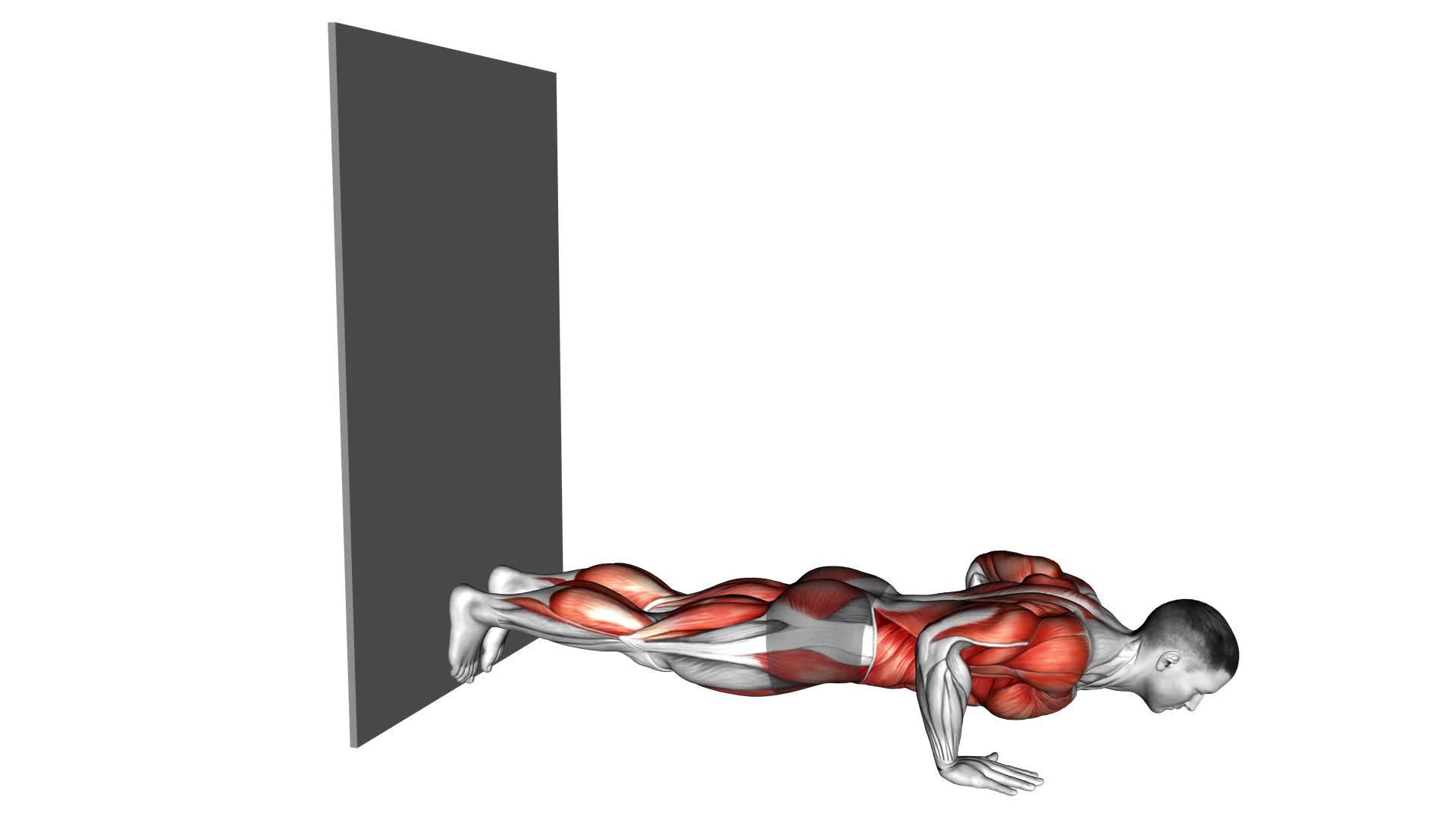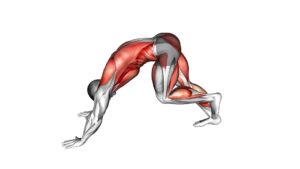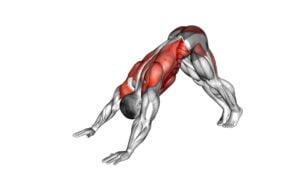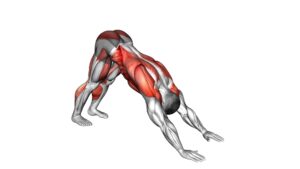Downward Dog Push-Up Against Wall (Male) – Video Exercise Guide & Tips

Get ready to take your workout to the next level with the Downward Dog Push-Up Against Wall.
Watch This Exercise Video
This exercise targets your upper body and core while providing a unique challenge.
In this video guide, you'll learn the proper form and technique, as well as variations and modifications to suit your fitness level.
Avoid common mistakes and maximize the effectiveness of this exercise with helpful tips.
Get ready to push yourself and see results!
Key Takeaways
- Targets upper body and core
- Improves range of motion
- Engages chest, shoulders, triceps, and core
- Provides stability and support
Benefits of Downward Dog Push-Up Against Wall
You should regularly perform downward dog push-ups against the wall to maximize the benefits for your upper body strength and flexibility. This exercise is a variation of the traditional push-up that targets multiple muscle groups while also improving your range of motion. When performing a downward dog push-up against the wall, you engage your chest, shoulders, triceps, and core muscles. The wall provides stability and support, allowing you to focus on proper form and muscle activation.
One of the main benefits of this exercise is increased muscle activation. By pressing your palms into the wall and lowering your body towards it, you engage your chest and triceps more effectively than with a regular push-up. This increased activation leads to greater strength gains in these muscles. Additionally, the downward dog position enhances flexibility in your shoulders and hamstrings.
To progress in this exercise, you can gradually increase the range of motion by moving your feet further away from the wall or by performing the push-up on the floor. If you find the exercise challenging, you can regress by performing it on an incline surface, such as a bench or step.
Incorporating downward dog push-ups against the wall into your regular workout routine won't only build upper body strength and flexibility but also add variety to your exercises. So, why not give it a try and reap the benefits for yourself?
Proper Form and Technique for Downward Dog Push-Up Against Wall
To perform a proper downward dog push-up against the wall, ensure that your palms are firmly pressed into the wall and your body is in a straight line from head to heels. This exercise not only targets your upper body and core muscles but also provides a deep stretch for your hamstrings and calves.
Here are some key points to remember for proper form and technique:
- Keep your hands shoulder-width apart and fingers spread wide for stability.
- Engage your core muscles by drawing your belly button in towards your spine.
- Press your heels down towards the ground to deepen the stretch in your legs.
- Maintain a slight bend in your elbows to avoid locking them out.
- Focus on keeping your neck relaxed and in line with your spine.
Proper form and technique are essential to maximize the benefits of downward dog push-ups against the wall. By maintaining the correct alignment and engaging the right muscles, you can strengthen your arms, shoulders, and core while also improving flexibility and mobility in your lower body.
Now, let's explore the variations and modifications for downward dog push-ups against the wall to challenge yourself further and customize the exercise to your fitness level.
Variations and Modifications for Downward Dog Push-Up Against Wall
For additional challenges and customization, explore the variations and modifications available for downward dog push-ups against the wall. One modification is to elevate your feet on a step or a block, which will increase the demand on your upper body and core muscles. Another modification is to perform the push-ups with one leg lifted off the ground, alternating between legs to work both sides equally.
If you're ready to take your downward dog push-ups to the next level, you can try advanced variations. One advanced variation is the pike push-up, where you start in a downward dog position and then lower your head towards the ground, keeping your body in a straight line. This variation targets your shoulders and triceps even more. Another advanced variation is the handstand push-up against the wall, where you kick up into a handstand position and then perform push-ups with your feet against the wall. This variation not only challenges your upper body strength but also your balance.
By exploring these variations and modifications, you can keep your downward dog push-ups against the wall challenging and exciting.
Now, let's move on to the next section to learn about the common mistakes to avoid during downward dog push-ups against the wall.
Common Mistakes to Avoid During Downward Dog Push-Up Against Wall
To ensure proper form and maximum effectiveness, it's important to avoid these common mistakes when performing downward dog push-ups against the wall:
- Placing hands too far away from the wall: Make sure to position your hands shoulder-width apart and at a comfortable distance from the wall. Placing them too far away can strain your shoulders and compromise your form.
- Sagging lower back: Keep your core engaged throughout the exercise to prevent your lower back from sagging. This will help maintain a straight line from your head to your heels, ensuring proper alignment and maximizing the benefits of the exercise.
- Rounding shoulders: Be mindful of your shoulder position. Avoid rounding your shoulders forward or shrugging them up towards your ears. Instead, focus on keeping them pulled back and down, which will help engage your upper back muscles and promote better posture.
- Lifting hips too high: While it's important to push back into a downward dog position, be cautious not to lift your hips excessively high. This can put unnecessary strain on your shoulders and limit the effectiveness of the exercise.
- Neglecting proper breathing: Remember to inhale as you lower your body towards the wall and exhale as you push back up. Proper breathing technique helps stabilize your core and enhances the overall effectiveness of the exercise.
By avoiding these common mistakes and focusing on proper technique, you can ensure that your downward dog push-ups against the wall are safe, effective, and help you achieve your fitness goals.
Keep pushing yourself and enjoy the benefits of this challenging exercise.
Tips for Maximizing the Effectiveness of Downward Dog Push-Up Against Wall
By maintaining proper form and incorporating these tips, you can maximize the effectiveness of your downward dog push-up against the wall. To ensure you get the most out of this exercise, it's important to avoid common mistakes and explore variations and modifications.
One common mistake to avoid is allowing your shoulders to collapse or rounding your upper back. Instead, focus on keeping your shoulder blades engaged and your chest open. This will help activate your chest, shoulders, and triceps more effectively.
Another mistake isn't engaging your core. By actively contracting your abdominal muscles, you not only create stability but also work your abs during the movement. This can help improve overall core strength and stability.
To increase the intensity of the exercise, you can try variations such as elevating your feet on a bench or using a stability ball. These modifications will challenge your upper body and core even more, helping to build strength and muscle.
Remember to always listen to your body and choose modifications that suit your fitness level. As you progress, you can gradually increase the difficulty of the exercise by exploring different variations and modifications. Stay consistent and push yourself to reach new heights with your downward dog push-up against the wall.
Frequently Asked Questions
How Many Calories Does a Downward Dog Push-Up Against the Wall Burn?
Downward dog push-up against the wall is a great variation of the traditional push-up. It targets your upper body muscles, including the chest, arms, and shoulders.
While the exact number of calories burned during this exercise can vary depending on factors such as your weight and intensity, it's generally an effective way to burn calories and build strength.
Incorporating downward dog push-up variations into your workout routine can provide numerous benefits for your overall fitness and muscle development.
Keep pushing yourself and enjoy the results!
Can Downward Dog Push-Ups Against the Wall Help Improve Flexibility?
Downward dog push-ups against the wall can definitely help improve your flexibility. By incorporating this variation into your workout routine, you can stretch and strengthen your muscles at the same time.
The downward dog position targets your shoulders, upper back, and hamstrings, allowing you to increase your range of motion over time. Not only will this exercise enhance your flexibility, but it will also improve your overall strength and stability.
Is It Necessary to Warm up Before Performing Downward Dog Push-Ups Against the Wall?
Before performing downward dog push-ups against the wall, it's important to warm up. Warming up helps prepare your muscles and joints for exercise, reducing the risk of injury. It also increases blood flow and flexibility, enhancing your performance.
If you're short on time, you can try alternatives to warm up such as dynamic stretching or light cardio exercises. Remember, taking a few minutes to warm up can greatly benefit your workout and help you achieve better results.
Can Downward Dog Push-Ups Against the Wall Help With Upper Body Strength?
Downward dog push-ups against the wall are a fantastic way to enhance your upper body strength. By incorporating this variation into your workout routine, you'll be targeting your arms, shoulders, and chest muscles.
These push-ups require you to engage your core and maintain proper form, which will only further benefit your overall strength and stability.
Are There Any Specific Breathing Techniques to Follow During Downward Dog Push-Ups Against the Wall?
When doing downward dog push-ups against the wall, it's important to focus on your breathing techniques. By taking deep breaths in through your nose and exhaling through your mouth, you can help oxygenate your muscles and stay focused during the exercise.
Remember to modify the exercise for beginners by starting with smaller movements and gradually increasing the range of motion.
With consistent practice and proper breathing, you'll improve your upper body strength and achieve great results.
Conclusion
Incorporating the downward dog push-up against the wall into your exercise routine can provide numerous benefits, including improved upper body strength and increased flexibility.
By maintaining proper form and technique, you can maximize the effectiveness of this exercise and avoid common mistakes.
Remember to listen to your body and make any necessary modifications or variations to suit your fitness level.
Stay motivated and keep pushing yourself to achieve your fitness goals with this challenging yet rewarding exercise.

Author
Years ago, the spark of my life’s passion ignited in my mind the moment I stepped into the local gym for the first time. The inaugural bead of perspiration, the initial endeavor, the very first surge of endorphins, and a sense of pride that washed over me post-workout marked the beginning of my deep-seated interest in strength sports, fitness, and sports nutrition. This very curiosity blossomed rapidly into a profound fascination, propelling me to earn a Master’s degree in Physical Education from the Academy of Physical Education in Krakow, followed by a Sports Manager diploma from the Jagiellonian University. My journey of growth led me to gain more specialized qualifications, such as being a certified personal trainer with a focus on sports dietetics, a lifeguard, and an instructor for wellness and corrective gymnastics. Theoretical knowledge paired seamlessly with practical experience, reinforcing my belief that the transformation of individuals under my guidance was also a reflection of my personal growth. This belief holds true even today. Each day, I strive to push the boundaries and explore new realms. These realms gently elevate me to greater heights. The unique combination of passion for my field and the continuous quest for growth fuels my drive to break new ground.







